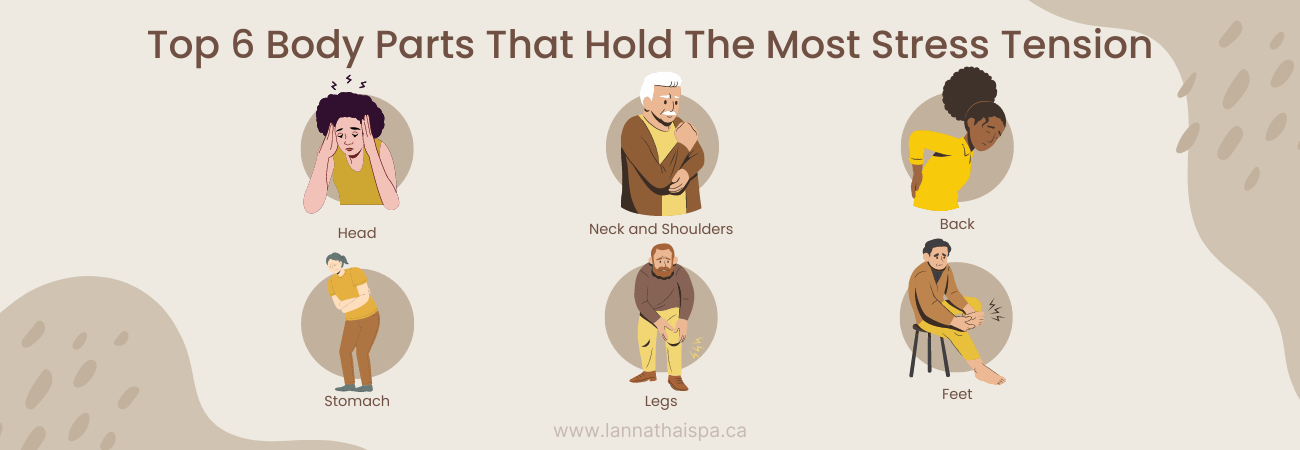Photo Credits to www.massgeneralbrigham.org
Stress tension is a normal part of everyday life. Things like traffic, work deadlines, household chores, relationship issues, and financial worries cause stress on both the mind and body.
Stress tension can build up in any part of the body, but some areas are more prone to it than others. As a result, you’ll often feel discomfort as the muscles tighten in these areas. Many people experience chronic pain and fatigue because of this. In fact, The American Institute of Stress reported that chronic illnesses increased from 48% in 2019 to 58% in 2023 because of stress.
Stress-relief techniques and wellness practices like deep breathing exercises, mindfulness meditation, and regular physical activity are all effective ways to manage and reduce overall tension. However, it’s important to learn how stress affects the body and which parts of the body hold the most stress tension.
How Does The Body Store Stress and Tension?
According to experts, unaccepted and unacknowledged feelings are major culprits of stress tension, resulting in psychosomatic responses in our bodies causing recurring pains and other mysterious ailments.
Stress and tension are primarily stored in the muscles, nervous system, and connective tissues. The body goes into “fight or flight” mode and muscles tense up, especially in areas like the neck, shoulders, and back. Chronic stress causes these areas to remain in a tense state, leading to pain, stiffness, and other physical symptoms. Additionally, stress can affect the digestive system, leading to issues like stomach aches or irritable bowel syndrome (IBS).
Body Parts That Hold Stress Tension
Ever had a headache in the middle of a busy day? A stomachache when you’re feeling nervous? These body parts are the most affected when you’re tense and stressed.

Head
If you feel like there’s a band of tightness that spans across your head then you might be experiencing what is called a tension type headache. This means that you’re stressed and holding tension in your head. Those who experience these types of headaches may also experience migraines.
Experts believe that tension that comes from feeling like you’re losing control of a situation or life in general gets stored in your head. Improve symptoms by accepting that you cannot control everything. Head massages, proper hydration, and sufficient rest will help, too!
Neck and Shoulders
You’ve probably heard of the adage “you carry the weight of the world on your shoulders”. This cannot be more true as strain is often put on our upper back, neck, and shoulders, creating tension that often leads to various aches and pains. Any type of musculoskeletal pain in the upper extremities has been linked to stress, and for many, this can be specifically linked to job stress.
Shouldering too many responsibilities causes stress tension to be stored in these upper extremities. Relieve tension by getting neck and shoulder massages to generate proper blood flow, loosen strain, and relax the tissue. More importantly, learn to ask for help and delegate responsibilities – you don’t always have to do everything on your own.
Back
We’ve all experienced back pain one way or another. Common causes of back pain include strenuous physical activity, poor posture, and stress-related tension. It is believed that tension from feelings of anger and frustration get stored in the back muscles, so it’s important to always address conflicts and avoid repressing your feelings.
Additionally, getting a soothing Thai massage is a great way to relax your back muscles and release built up tension.
Stomach
Feeling a “knot” in your stomach or having a “nervous stomach” is something we all experience from time to time. The muscles in our stomach contract and store tension whenever we feel anxious or stressed. We also say something like “I’m sick to my stomach,” which is one way the body responds to conflict.
Feelings scared and hopeless are what causes tension stress to get stored in the stomach. The more you acknowledge fear and do something about it, the less of a hold it will have on your body. It’s important to manage anxiety and stress through simple practices like eating healthy meals, exercising, and staying on top of your priorities.
Legs
It’s understandable that our legs often feel sore or strained because we use them so much, especially when we spend a lot of time walking or frequently work out at the gym. However, lack of movement can also cause our leg muscles to tense up because they are subject to restlessness and stiffness after extended periods of no movement.
Similar to other body parts on this list, our legs are often involved whenever we feel stressed. Rest and massage therapy are effective ways to release tension from the legs.
Feet
Did you know that your feet have more than 100 muscles, ligaments, and tendons? The feet are responsible for supporting the entire weight of the body and are used for walking, running, and many other physical activities. No wonder why we easily feel tension in our feet!
When you’re stressed, blood flow to the feet is reduced, leading to feelings of discomfort like coldness or numbness in your feet. You may notice that your feet may feel cold or tingly when you’re anxious or nervous. Reflexology and massage therapy are great ways to release stress tension from the feet.
In A Nutshell
Our head, neck and shoulders, back, stomach, legs, and feet are the most affected when we go through stressful times. It’s important to address anxiety, stress, and repressed feelings in order to release tension stress from these areas and the whole body. Self-care and wellness practices are also important in keeping stress at bay, leading to a healthier, more relaxed body.



